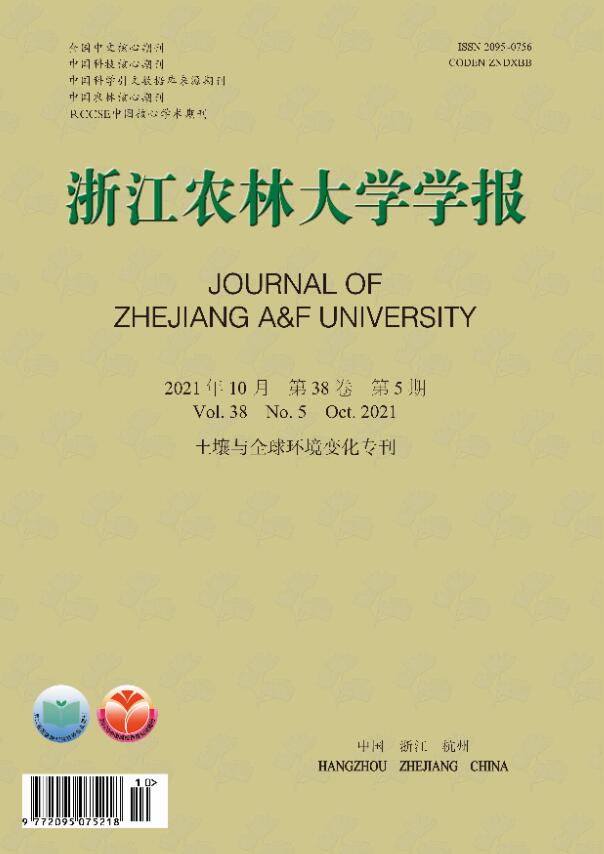-
氮素是植物生长过程中需求量最大的矿质营养元素。全球气候变化下,气温升高、二氧化碳(CO2)增加提高了植物碳同化速率[1-2],进一步加剧了植物对氮的需求。森林生态系统中90%的氮素都存在于土壤中,但大多数氮素不能直接被植物吸收利用。因此,如何加速氮素转化,提高氮素利用效率已成为亟待解决的问题。研究表明:植物可以通过根系分泌物的输入刺激土壤有机质的微生物分解来加速氮素循环,影响根际氮动态[3]。土壤氮转化主要包括固氮作用、硝化作用、反硝化作用和氨化作用4个过程,以上过程均由微生物驱动[4]。氮气(N2)分子三键的强稳定性导致不能被大多数生物直接利用,只能通过原核生物(细菌或古菌)的固氮作用,将N2还原为铵离子(NH4 +)。NH4 +也容易被土壤微生物氧化,发生硝化作用,即主要由氨氧化细菌(ammonia-oxidizing bacteria, AOB)、氨氧化古菌(ammonia-oxidizing archaea, AOA)催化完成的氨氧化过程和亚硝酸盐氧化细菌和完全氨氧化微生物催化完成的亚硝酸盐氧化过程[5-6]。其中,亚硝化作用被认为是全球氮循环的中心环节,然而,氨氧化细菌和氨氧化古菌的固氮作用主要局限于海洋和淡水沉积物[7],对森林固氮作用有限。有研究表明:在气温升高和CO2增加的条件下,植物会通过改变自身的地下根系分泌物的输入速率和组分控制根际界面的生物和非生物过程,加速氮素矿化,缓解植物快速生长的养分限制[8-11]。根系分泌物由于含丰富的碳源和氮源,它的输入通过改变微生物数量和活性,深刻影响土壤有机质分解和养分代谢过程[9-10]。但森林生态系统中植物种类繁多,植物根系分泌物组成成分复杂,且不同植物的根系分泌物分泌速率不同,对有机质矿化和氮素转化过程的影响存在较大差异。模拟根系分泌物输入试验是通过原位收集测定根系分泌物的物质组成、含量及输入速率,进而探究根系分泌物输入变化对根际土壤养分转化过程的影响。相关模拟根系分泌物输入的研究表明:根系分泌物既能促进土壤氮素从有机态向无机态转化,显著提高氮素矿化速率,又能抑制硝化作用和促进反硝化过程,降低氮素流失量[12-13]。但根系分泌物对土壤氮转化的影响复杂,且是多方面的,目前缺乏相关的总结性综述。基于此,本研究主要综述了根系分泌物模拟输入对森林土壤氮矿化、硝化、反硝化过程的影响,以期为今后开展根系分泌物和氮素转化相关研究提供科学依据和理论指导。
-
根系分泌物是植物生长过程中通过根系分泌到土壤中的多种可溶性有机化合物的总称[14],占植物光合作用碳同化总量的5%~21%[15]。植物根系通过释放根系分泌物中的含碳物质到根际土壤中,刺激土壤微生物群落活动[16-17],加速土壤有机质的分解,促进土壤氮素矿化。
根系分泌物碳输入所介导的根际氮矿化过程主要与输入量及输入速率有关。目前,多以原位测定的根系分泌物碳输入速率为研究基础,模拟输入量及输入速率梯度展开研究。MEIER等[9]通过模拟根系单位表面积不同碳输入速率(0、20、100和200 mg·cm−2·d−1)发现:当碳输入速率为20 mg·cm−2·d−1时,显著增加了N-乙酰-β-D-葡萄糖苷酶活性,当碳输入速率为100 mg·cm−2·d−1时,显著提高了蛋白水解酶活性,对土壤的总氮矿化有积极作用。LANGARICA-FUENTES等[18]以多年生落叶松Larix gmelinii根系碳输入速率的0~2倍模拟添加试验(0、0.375、0.750、1.500和3.000 mg·cm−2·d−1)的结果显示:随着碳输入速率的增加,土壤中铵态氮(NH4 +-N)显著增加,并在分泌速率为3.000 mg·cm−2·d−1时达到最高。YUAN等[19]研究发现:添加草酸和葡萄糖均可提高β-1,4-N-乙酰氨基葡糖苷酶和多酚氧化酶的活性,草酸使云杉Picea asperata人工林和天然林土壤的潜在净氮矿化率分别增加89%和150%,葡萄糖使其分别增加了45%和104%。但是含碳物质的输入超过一定含量时,酶活性反而下降,有机质的分解减少[20]。以上研究(表1)均表明:一定量的根系分泌物碳输入可以提高相关氮转化酶的活性,促进有机氮的矿化。因此,树木可以通过控制根系碳的分泌速率影响根际氮素矿化。
森林类型 土壤类型 种类 输入量或输入速率 输入方式 影响 文献 云杉和冷杉 Abies fabri 棕色森林土壤 葡萄糖、草酸 单位根系表面积碳输入速率为5 μg·cm−2·h−1 蠕动泵连续添加 提高酶活性,促进氮矿化 [19] 火炬松 Pinus taeda 辉绿岩发育的微酸性土壤 富马酸、丙二酸、草酸、柠檬酸、葡萄糖、果糖和蔗糖 单位根系表面积碳输入速率为0、20、100和200 mg·cm−2 ·d−1 蠕动泵连续添加 增加土壤微生物对氮的降解 [9] 栎树 Quercus 潮土,母质为砂质沉积物 葡萄糖,丙氨酸 单位质量的土壤添加碳为
1 mg·g−1一次性
添加丙氨酸产生最大的激发效应,增加土壤微生物活性 [21] 常绿阔叶林 酸性土壤 D-葡萄糖、D-果糖、D-木糖、草酸、延胡索酸、琥珀酸、乙酸、L-脯氨酸、L-精氨酸、L-甘氨酸、丝氨酸和谷氨酸 单位质量的土壤添加碳为0、0.3、0.6、1.2 mg·g−1 一次性
添加添加0.6和1.2 mg·g−1碳显著提高氮转化相关酶的活性 [22] − 棕色森林土壤 葡萄糖、蔗糖、果糖、核糖、阿拉伯糖、甘氨酸、缬氨酸、谷氨酰胺、丝氨酸、丙氨酸 苹果酸、柠檬酸、丙二酸、草酸和延胡索酸 添加碳为0、0.375、0.750、1.500和3.000 mg·d−1 注射器连续添加 提高NH4 +-N含量,显著增加反硝化速率 [18] 北美红栎 Quercus rubra和红花槭 Acer rubrum 砂质壤土,母质为冰川碛物 柠檬酸、草酸、富马酸、丙二酸和葡萄糖,氯化铵(NH4Cl)模拟氮含量 仅含碳,碳质量浓度为
500 mg·L−1;碳氮比为10蠕动泵连续添加 提高土壤微生物生物量、微生物活性和外切酶活性 [23] 栎木 Quercus spp.和马尾松 Pinus massoniana 微酸性土壤,母质为砂岩和页岩 柠檬酸、草酸,富马酸、丙二酸和葡萄糖 仅含碳,添加碳为
0.053 6 g·m−2·d−1;碳氮比为10,添加碳为0.021 6 g·m−2 ·d−1;碳氮比为25,添加碳为0.053 6 g·m−2·d−1每次定量连续添加 增强酶功能 [24] 云杉 暗棕壤 葡萄糖、柠檬酸和谷氨酸 仅含氮,氮质量浓度为
6 mg·L–1;碳氮比为10、50、100;碳质量浓度为60 mg·L−1每次定量连续添加 增加胞外酶分泌,加速土壤有机质分解和无机氮释放 [25] 说明:−表示文献中无森林类型信息 Table 1. Effects of root exudates on soil nitrogen transformation
-
根系分泌物碳输入对氮矿化的影响机制主要可以分为生物和非生物作用。生物作用主要是指根系分泌物碳输入通过影响根际微生物,来影响土壤氮矿化。一方面根系碳输入可以为土壤微生物提供碳源,增加微生物的活性和数量,提高氮素矿化相关胞外酶的产量,从而刺激和激发土壤有机质分解和转化[26]。如NOBILI等[27]和KUZYAKOV等[28]研究发现:通过向土壤中添加有效的低分子底物(例如葡萄糖和氨基酸)可以促进激发效应,激活休眠的土壤微生物,增加土壤微生物量。另一方面,含碳物质的分泌还可以作为根际微生物的化学引诱物质,招募特定的微生物,改变群落的组成和多样性。如LANDI等[29]研究表明:葡萄糖和草酸的添加均能影响森林土壤细菌群落,葡萄糖偏向促进土壤微生物有机体的合成,草酸则被土壤中的某一种专一微生物利用。YUAN等[19]研究发现:添加草酸可以增加某些特殊的微生物种类定殖(如K策略相关微生物),产生大量与氮转化相关的酶(如N-乙酰-β-D-葡萄糖苷酶),从而进一步分解有机质,增强氮的释放。除了生物作用,根系碳分泌也可通过非生物作用过程,如保护态碳活化、微生物对有机碳的可接近性等影响氮矿化过程。例如,KEILUWEIT等[30]发现:输入草酸打破了空间隔离效应,增加了保护态碳的微生物可达性,通过配位络合作用和溶解反应等物理化学作用,破坏或者降低了土壤有机物-矿质复合体界面的稳定性,从而将土壤中保护态碳从土壤有机-矿质复合体中释放出来,供微生物分解和利用。YUAN等[19]也发现:草酸的添加破坏了有机-矿质复合体,显著降低了有机-矿质复合体中受保护的铁和铝的含量,导致有机物分解,增加氮的矿化来源。总之,根系碳分泌物可以通过生物和非生物作用影响氮矿化过程,但是由于根系碳分泌物组分的复杂性,根系分泌物中不同组分对氮矿化的作用效果及作用机制缺乏研究。
-
森林根系分泌物研究大都仅关注根系碳源输入对土壤过程和功能的影响,而忽略了根系分泌物中氮成分变化及其伴随的碳氮比化学计量特征对土壤生态过程与调控机制的系统性研究,极大地限制对森林根系-土壤-微生物互作机制的深入认识[26]。例如有机酸和碳水化合物虽然是根系分泌物的主要化学物质,但有研究也发现了氨基酸等含氮物质的大量存在[31-32],且在调控氮素转化过程中起关键作用。然而由于根系和微生物活动对根际有效氮素的获取和激烈竞争,使得根际区通常成为碳过剩而氮受限制强烈的区域[33]。大量研究表明:当土壤氮素较低时,根系分泌物刺激土壤有机质分解合成额外的氮[34-35]。因此,根系分泌物氮或碳氮比也是驱动根际微生物群落组成和活性的重要调控因子。
DRAKE等[23]模拟根系分泌物中的柠檬酸、草酸、富马酸、丙二酸和葡萄糖等5种含碳物质,并用氯化铵配成碳氮比为10的添加液,结果表明:相比只含碳的根系分泌物,同时输入含有碳和氮的根系分泌物可显著提高土壤微生物活性、微生物生物量以及分解土壤低分子量有机物(如纤维素,氨基糖)的胞外酶活性,显著促进氮素矿化。TIAN等[24]在DRAKE等[23]的研究基础上增加了碳氮比为25的处理,以模拟在CO2增加的情况下根系分泌物的化学计量变化[11],结果表明:碳氮比为10和25的处理均增强了与氮矿化相关的酶活性,并且碳氮比为25的处理还显著增加了土壤碳含量。梁儒彪等[25]模拟根系分泌物碳氮比化学计量特征(仅含碳,碳氮比为10、50、100)对川西亚高山森林土壤碳动态和微生物群落结构的影响表明:森林根系分泌物氮源输入和土壤氮有效性共同调控根系碳源输入对土壤有机质分解激发效应的方向和幅度。综上所述,相比只含碳的根系分泌物,添加适宜碳氮比的根系分泌物可显著提高土壤微生物活性和酶活性,对有机质的分解具有正效应。
-
不同碳氮比根系分泌物的输入对氮矿化的影响机制主要是养分的输入或养分的有效性对有机物的矿化分解过程产生影响。该过程目前主要存在2种假说:微生物氮矿化假说与化学计量分解理论假说。微生物物氮矿化假说认为:外源碳的添加为土壤获取氮微生物提供能源,提高其微生物活性,进而刺激土壤惰性有机质分解和养分转化过程[36]。化学计量分解理论假说则认为:添加外源碳和氮满足土壤微生物需求时,其化学计量值高度匹配时,土壤微生物活性最高,分解速率最大[37]。2种假说代表了氮养分有效性对土壤有机质稳定性相反的影响效应。第1种假说表明氮有效性低,有利于土壤有机质的分解;第2种假说表明氮有效性高,有利于土壤有机质的分解[38]。梁儒彪等[25]研究表明:只含碳和碳氮比为100(氮含量基本忽略)的处理显著降低土壤全碳含量,而添加适量的氮(只含氮、碳氮比为10和50)在一定程度上缓和了土壤全碳含量的降低。其原因是低含量的有效氮促使微生物分泌更多的胞外酶,加速了土壤有机质的分解,使土壤全碳含量显著降低,而添加一定量的氮组分缓和了土壤氮的限制,使得微生物偏好利用易于分解的有机化合物,缓和了土壤全碳含量的降低幅度[25]。该研究结果证实了微生物氮矿化假说。CHEN等[38]研究显示:蔗糖和氮添加显著加速有机质的矿化,但有机质矿化的速率由氮有效性控制,表明高氮有效性有利于有机质的分解。该研究结果支持化学计量分解理论。根系分泌物通过控制输入土壤的养分化学计量比,介导着微生物行使不同的有机质分解和矿化策略,这对调控土壤养分利用方向和提高养分利用率具有重要意义。
-
目前森林土壤矿化相关研究大多围绕有机酸和糖类开展。有机酸类和糖类通常由植物根系、菌根和菌丝分泌,且是最丰富的两类根系分泌物[39]。这两类物质在根系分泌物含碳物质中占的比例最高,当外界环境变化时最容易引起这两类物质含量的变化[40]。MEIER等[9]通过蠕动泵连续添加根系分泌物的方式,选择已发现的有机酸和单糖种类,模拟添加有机酸(富马酸、丙二酸、草酸和柠檬酸)和单糖(葡萄糖、蔗糖和果糖) (体积比为3∶1,比例接近成熟树木原位收集的根系分泌物中的有机酸和糖的比例)对氮素矿化的影响,发现有机酸和单糖的添加显著增强了降解氮素的酶活性,并增加了降解氮素微生物的分配比例。DRAKE等[23]和TIAN等[24]添加柠檬酸、草酸、富马酸、丙二酸和葡萄糖,梁儒彪等[25]添加葡萄糖和柠檬酸也发现相似的结果。YUAN等[19]研究发现:草酸和葡萄糖虽然显著促进了氮矿化和增加氮有效性,但葡萄糖的增强作用明显小于草酸,其原因是草酸不仅可以充当含羧基的碳源,而且还可以充当络合金属的配体,通过络合和溶解受保护的有机-矿质复合体,加速土壤微生物分解有机物。而葡萄糖增加了有机-矿质复合体的形成,从而限制了微生物的获取。另外,微生物对葡萄糖的优先利用也会导致较低的氮分解。BERNAL等[21]研究还发现:根系分泌物还对深层(2.7~3.0 m)土壤有机质矿化有积极作用,向深层土壤中添加葡萄糖和丙氨酸后,土壤酚氧化酶和过氧化物酶活性增加了13倍,显著降低了土壤微生物生物量和微生物磷脂脂肪酸含量,而且添加丙氨酸还产生了最大的激发效应。可见,根系分泌物在森林生态系统植物氮素需求供应中起着关键作用。
除了有机酸和糖类以外,根系还会分泌一些其他物质影响土壤氮转化。目前相关研究报道主要集中在以下几个方面:①根系分泌物中含有大量的氨基酸、蛋白质等含氮物质,这些物质可以改变土壤的氮组分和含量,影响氮转化;②根系分泌物中有强黏着力的高分子多糖,能显著改善土壤微团聚体的稳定性及大小分布等物理性质,间接影响土壤氮素的矿化[41];③植物根系分泌物也是土壤酶的重要来源之一,包括磷酸酶、转氨酶、淀粉酶、蛋白酶、多聚半乳糖醛酸酶等,可作为土壤碳、氮元素转化的催化剂,影响氮素转化[14]。
-
硝化作用指NH4 +氧化为亚硝酸根离子(NO2 −)的氨氧化过程和NO2 −氧化为硝酸根离子(NO3 −)的亚硝酸盐氧化过程。有研究表明:植物可以通过分泌某些物质来抑制土壤硝化作用,植物根系产生和分泌能抑制土壤硝化作用物质的能力被称为生物硝化抑制作用,植物根系产生和分泌的抑制硝化作用的物质,被称为生物硝化抑制剂(biological nitrification inhibitor, BNI)[42]。生物硝化抑制剂通过抑制AOB、AOA及相关酶,即氨单加氧酶(ammonia mono oxygenase, AMO)和羟胺氧化还原酶(hydroxylamine oxidoreductase, HAO)活性来抑制土壤硝化作用,降低NO3 −的淋溶[43]。目前已在高粱Sorghum bicolor[44-46]、小麦Triticum aestivum[47]、水稻Oryza sativa[48-49]、臂形草Brachiaria humidicola[12]中发现了生物硝化抑制剂的存在。这些被鉴定的硝化抑制剂中,臂形草内酯(brachialactone)、高粱醌(sorgoleone)和樱花素(sakuranetin)能通过抑制氨单加氧酶和羟胺氧化还原酶抑制土壤硝化作用,而对羟基苯丙酸甲酯[methyl 3-(4-hydroxyphenyl) propionate, MHPP]和1,9-癸二醇(1,9-decanediol)只能通过抑制氨单加氧酶抑制土壤硝化作用(表2)。在卡兰贾树Pongamia glabra中发现名为水黄皮素的生物硝化抑制剂,可以抑制氨氧化细菌的活性,其种子中有一种结晶的成分会改变生物硝化抑制剂的活性[50],硝化作用抑制程度可达65%~75%[51],能够显著提高氮素利用率。
-
根系分泌物的输入对土壤硝化作用的抑制主要表现在抑制土壤中NH4 +向NO3 −的转化。目前已发现的生物硝化抑制剂抑制硝化作用的机制主要是:含有生物硝化抑制活性的亚油酸和α-亚麻酸很可能具有抑制硝化所需的结构和链长,能同时抑制氨单加氧酶和羟胺还原酶[52]。此外,生物硝化抑制剂还扰乱羟胺还原酶到辅酶(ubiquinone)和细胞色素(cytochrome)的电子传递途径,影响氨氧化过程的代谢功能[53]。也有研究表明:化感物质会通过影响微生物抑制土壤硝化作用[54],而高粱等植物的根系分泌物均属于化感物质,在一定程度上影响硝化作用。根系分泌物输入对土壤硝化作用的调控与土壤氮素水平有关。在NH4 +为0~1 mmol·L−1时,高粱和水稻生物硝化抑制剂的分泌量随NH4 +浓度的增加而显著增强,但当NH4 +大于1 mmol·L−1时,生物硝化抑制剂的分泌不再提高[55-56]。此外,还和氮素形态有关,在以NO3 −为氮源时,生物硝化抑制剂的分泌量少,而以NH4 +为氮源时则大量分泌[52]。其原因是由于土壤中NH4 +的积累会诱导亚硝化细菌活性的增强[57]。
-
反硝化作用是异氧微生物在缺氧或者厌氧情况下将NO3 −或者NO2 −还原为一氧化氮(NO)、一氧化二氮(N2O)和N2的过程。植物根系的生长和活动显著影响土壤中的反硝化过程,导致根际土壤中的反硝化作用比非根际土壤强[58-59]。然而,由于影响根际土壤反硝化过程的因素较多,导致根系分泌物在反硝化过程中的具体作用知之甚少[60]。
根系分泌物的种类和含量对土壤反硝化作用影响不同。LANGARICA-FUENTES等[18]模拟不同种类(葡萄糖、蔗糖、果糖、核糖和阿拉伯糖、甘氨酸、缬氨酸、谷氨酰胺、丝氨酸和丙氨酸、苹果酸、柠檬酸、丙二酸、草酸和延胡索酸)、不同碳含量(0、0.375、0.750、1.500和3.000 mg·d−1)根系分泌物输入试验中发现:根系分泌物的碳输入显著促进土壤反硝化速率。庄姗等[61]通过室内模拟根系分泌物输入试验发现:草酸、丝氨酸、葡萄糖3种主要根系分泌物均能促进土壤N2O排放。GILES等[62]研究发现:添加葡萄糖、谷氨酰胺和柠檬酸也能显著促进N2O的排放,并且N2O的排放速率由底物的类型和利用效率决定,调节碳化合物的有效性可以降低N2O的排放。根系分泌物的量也影响土壤中N2O的产生量。GUYONNET等[63]发现:土壤N2O的产生量与根际土壤中丁酸和琥珀酸的相对含量呈正相关。小分子有机物(甲酸盐和葡萄糖)的微量添加也能刺激土壤N2O的排放[64]。可见,根系分泌物的输入促进了土壤反硝化作用,增加了N2O的排放。
-
根系分泌物的输入对土壤反硝化作用的影响机制主要有以下几点:①根系分泌物可以加速氮矿化,促进氮释放。如草酸和葡萄糖均能显著促进土壤中有机态氮和有机复合态氮的矿化速度,促进氮的释放[19]。②根系分泌物和根系呼吸降低了氧气的利用率,促进反硝化作用[1, 65]。③根系分泌物可以调控氮素转化相关酶活性基因的表达,从而影响反硝化过程。反硝化过程由narG/napA、nirK/nirS、norB/nosZ基因编码的特定还原酶执行[66]。主要包括催化NO2 −还原为NO的亚硝酸盐还原酶(由nirK或nirS编码),催化NO还原为N2O的NO还原酶(由norB编码)和将N2O转化为惰性N2的还原酶(由nosZ编码)[66]。通过控制基因表达调控土壤酶活性从而影响反硝化过程。④根系分泌物显著影响反硝化细菌群落[62, 67-68]。例如LANGARICA-FUENTES等[18]研究证实:根系分泌物会导致土壤细菌总数和反硝化菌群落规模和结构发生变化,增加反硝化速率。但是有些研究却发现根系分泌物输入虽然可以显著增加反硝化速率,但是对反硝化细菌的结构和丰度影响不大[69-70]。
-
根系分泌物介导的氮素转化的研究报道主要在增加土壤氮素矿化速率,抑制土壤硝化作用,及促进土壤反硝化过程3个方面。根系分泌物调控的根际土壤氮素转化过程为今后全球气候变化下的植物氮素需求研究提供了新方向。然而当前研究仍存在不足之处:①目前已经有部分研究发现了根系分泌物影响氮转化的现象,但其具体的作用机制以及作用过程还有待更进一步研究。②根系分泌收集困难,组分繁多,各组分含量较低,分离鉴定难度较大,且极易被微生物降解,目前较多研究集中在含量较高、且易分离鉴定的物质,很多成分还没有进行过研究。③当前农业生态系统生物硝化抑制剂研究较多,而森林生态系统中,生物硝化抑制剂的报道很少,一定程度上限制了对森林土壤硝化过程的认识。因此,未来研究要聚焦森林生态系统中的植物分泌哪些生物硝化抑制剂来促进氮素转化和减少氮素损失,及其作用机制。这对推动森林生态系统养分循环研究具有指导性意义。④气候变化下根系分泌物介导的森林生态系统氮素转化过程仍是未来研究的重点。森林生态系统中,大气CO2和气温升高的情况下,会导致根系分泌物分泌速率加强以加速氮素矿化[8-11]。但是,目前尚不清楚由于气候变化而导致的根系分泌速率增加如何影响氮转化的其他过程,例如硝化作用和反硝化作用等过程。
Effect of simulated root exudates input on soil nitrogen transformation: a review
doi: 10.11833/j.issn.2095-0756.20210293
- Received Date: 2021-04-16
- Rev Recd Date: 2021-07-31
- Available Online: 2021-10-12
- Publish Date: 2021-10-20
-
Key words:
- root exudates /
- nitrogen /
- forest soil /
- mineralization /
- primary productivity
Abstract: Global climate change accelerates plant growth and biomass accumulation, and nitrogen has become one of main limiting factors for primary productivity in forest ecosystems. The microbial process mediated by root exudates in rhizosphere is of great significance in driving soil nutrient cycle and increasing nitrogen availability. This study reviewed the effects and mechanisms of simulated root exudates input on soil nitrogen mineralization, nitrification, and denitrification. It was found that organic acids, sugars, and amino acids in root exudates accelerated the decomposition of organic matter and nitrogen mineralization, which partly alleviated the demand of plants for nitrogen. Root exudates inputs with different carbon content and C/N ratio drove rhizosphere microorganisms to exercise different nutrient utilization strategies. Through biological and abiotic effects, root exudates mineralized nitrogen in organic matter and supplied it to plants for absorption and utilization. Biological nitrification inhibitors in root exudates inhibited soil nitrification and reduced nitrogen leaching. Root exudates also promoted soil denitrification by controlling the denitrifying bacterial community in the rhizosphere. In conclusion, plants can improve underground carbon distribution and affect nitrogen transformation in rhizosphere soil by increasing the input of root exudates, which is vital for maintaining nitrogen cycle and alleviating nutrient limitation. [Ch, 2 tab. 70 ref.]
| Citation: | CAI Yinmei, ZHANG Chengfu, ZHAO Qingxia, et al. Effect of simulated root exudates input on soil nitrogen transformation: a review[J]. Journal of Zhejiang A&F University, 2021, 38(5): 916-925. DOI: 10.11833/j.issn.2095-0756.20210293 |









 DownLoad:
DownLoad: